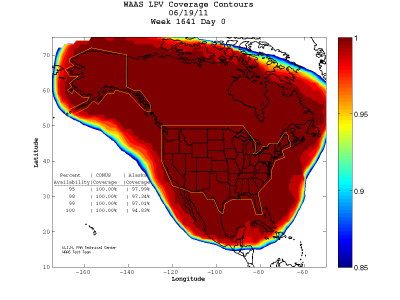If you wish to contribute or participate in the discussions about articles you are invited to contact the Editor
WAAS Performances: Difference between revisions
| Line 83: | Line 83: | ||
|} | |} | ||
Typical performances provided by WAAS System when considering operating in LPV (Horizontal Alarm Limit = 40 m , Vertical Alarm Limit =50 m) are shown in next figure: | Typical performances provided by WAAS System when considering operating in LPV (Horizontal Alarm Limit = 40 m , Vertical Alarm Limit =50 m) are shown in next figure:<ref>[http://www.nstb.tc.faa.gov/24Hr_WaasLPV200.htm FAA Monitoring WAAS Performances in Real-Time]</ref> | ||
[[File:WAASCoverage LPV.png|center|thumb|400px|Typical WAAS LPV Coverage]] | [[File:WAASCoverage LPV.png|center|thumb|400px|Typical WAAS LPV Coverage]] | ||
Revision as of 15:47, 20 June 2011
| WAAS | |
|---|---|
| Title | WAAS Performances |
| Author(s) | GMV. |
| Level | Basic |
| Year of Publication | 2011 |
The Wide Area Augmentation System (WAAS) is an GPS Augmentation system developed by the Federal Aviation Administration (FAA), with the goal of improving its accuracy, integrity, and availability. Essentially, WAAS is intended to enable aircraft to rely on GPS for all phases of flight, including precision approaches to any airport within its coverage area.
WAAS Performances
Performances are usually described in terms of accuracy, integrity, availability and continuity. The WAAS specification Performance Requirements[1] are different depending on the phase of the flight: en route through 1) Non-precision approach (NPA) and 2) Precision Approach.
1) WAAS Performance Requirements for Non-Precision Approach are summarized in the following table:
| Performance Requirement | Total System | Navigation System | WAAS Signal-in-Space | Airborne |
|---|---|---|---|---|
| Availability | 0.999 | 0.999 | 0.999 | Not Specified (N/S) |
| Accuracy 95% Horizontal Position 99.999% Horizontal Position 95% Vertical Position 95% Pseudorange |
N/S N/S N/A N/A |
100 m 500 m N/A N/S |
N/S N/S N/A N/S |
N/S N/S N/A 1.2 m |
| Integrity Integrity Risk Time-to-Alarm |
N/S 10 s |
N/S 10 s |
10e-7/hour 8 s |
N/S 2 s |
| Continuity Continuity of Navigation Continuity of Fault Detection |
1 - 10e-5/hour 1 - (2x10e-5)/hour |
1 - 10e-5/hour 1 - (2x10e-5)/hour |
1 - 10e-8hour 1 - 10e-5/hour |
1 - 10e-5/hour 1 - 10e-5/hour |
2) WAAS Performance Requirements for Precision Approach are summarized in the following table:
| Performance Requirement | Total System | Navigation System | WAAS Signal-in-Space | Airborne |
|---|---|---|---|---|
| Availability | Not Specified (N/S) | N/S | 0.999 | N/S |
| Accuracy 95% Horizontal Position 95% Vertical Position 95% Pseudorange |
33.5 m 9.8 m N/A |
7.6 m 7.6 m N/S |
N/S N/S N/S |
N/S N/S 1.2 m |
| Integrity Integrity Risk Time-to-Alarm |
N/S N/S |
N/S N/S |
10e-7/approach 5.2 s |
N/S N/S |
| Continuity of Function Continuity of Navigation Continuity of Fault Detection |
1 - 10e-4/approach N/S N/S |
1 - 10e-4/approach N/S N/S |
1 - (5.5x10e-5)/approach N/S N/S |
1 - (4.5x10e-5)/approach N/S N/S |
Typical performances provided by WAAS System when considering operating in LPV (Horizontal Alarm Limit = 40 m , Vertical Alarm Limit =50 m) are shown in next figure:[2]
Notes
References
- ^ FAA.Specification for the Wide Area Augmentation System(WAAS). FAA-E- 2892b. August 13, 2001.
- ^ FAA Monitoring WAAS Performances in Real-Time

